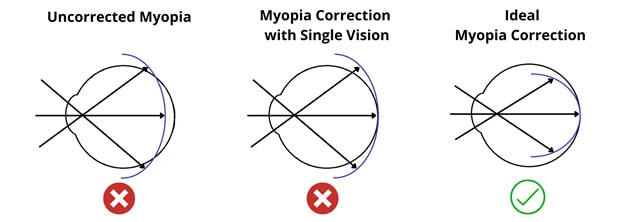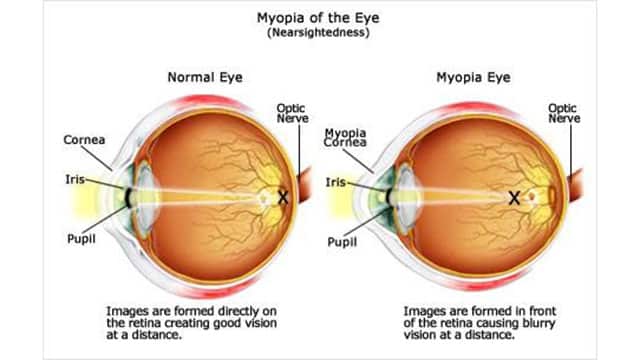

Various demographic characteristics have been shown to be associated with high myopia. Myopia is the most common refractive error and affects ~25% of adults in the United States. The American Academy of Ophthalmology Basic Clinical Science Course defines pathologic myopia as refractive error greater than ?6 D, with axial length in excess of 26.5 mm. Pathologic myopia has also been defined as high myopia accompanied by visual dysfunction. Duke-Elder defined pathologic myopia as myopia accompanied by degenerative posterior segment changes. Pathologic myopia has been assigned varying definitions in the ophthalmic literature. Pathologic, myopia occurs when progressive increase in axial length causes excessive thinning of the sclera, retina, retinal pigment epithelium (RPE) and choroid, resulting in varying degrees of visual disability. Myopia occurs when an object image is formed anterior to the retinal surface, due to an excessively steep corneal curvature, an abnormally spherical lens, an increase in lenticular index of refraction as in nuclear sclerosis, or more commonly, as a result of increased axial length. Myopia, or nearsightedness, is the most common ocular condition. As yet, there is no proven method to prevent the axial elongation and the myriad resulting posterior segment complications described in pathologic myopia. Surgical treatments to displace the myopic CNV have also been utilized in attempts to salvage remaining visual acuity in these eyes.Īnticholinergic therapy is being studied as a way to slow myopic degeneration. Antiangiogenic therapy is a promising treatment option. Photodynamic therapy (PDT) has been established as a treatment to preserve visual acuity for subfoveal myopic CNV.

Argon laser has been used to treat extrafoveal CNV with a high rate of posttreatment recurrence. Myopia-related CNV lesions are usually self-limited, and are smaller and less exudative than CNV observed in age-related macular degeneration (AMD). The most common visually threatening complication of pathologic myopia is choroidal neovascularization (CNV). Numerous complications, such as posterior vitreous detachment (PVD) and abnormal vitreoretinal interface, retinal detachment (RD), posterior staphyloma, macular hole, lacquer cracks (spontaneous breaks in Bruch's membrane), subretinal hemorrhage, lead to visual disability. Defective collagen fibril formation results in biomechanically weak sclera and progressive globe elongation. The pathogenesis of pathologic myopia is not known.

It is a multifactorial disorder with genetic, environmental, and socioeconomic etiologies. Pathologic, or degenerative myopia, has been defined as refractive error more negative than ?6 D, and is a leading cause of blindness in Asian countries. Albert & Jakobiec's Principles & Practice of Ophthalmology, 3rd Edition CHAPTER 154 - Pathologic Myopia


 0 kommentar(er)
0 kommentar(er)
